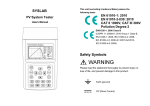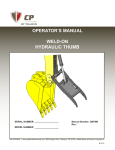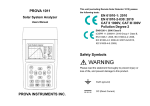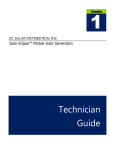Download THE 10 COMMANDMENTS OF GOOD BATTERY CARE
Transcript
THE 10 COMMANDMENTS OF GOOD BATTERY CARE • Place battery into service and complete a full discharge and charge cycle. Check and Watering add approved water only (never acid) if needed only after this first cycle is completed. Instructions Water • Never discharge battery beyond 80% and do not operate battery if the specific gravity Approved In most areas of the United States, tap water is satisfactory for use in lead acid is below 1.150sg. for Powerline™, Water Less® and Top Power® and 1.175sg. for batteries. Use distilled water when in doubt. Energy-Plus™. • If above 115° F allow battery to cool before charging or operating. Proper Electrolyte Level The electrolyte level must be kept • During shipment or prolonged storage the electrolyte levels may fall below the between the “High Watering Level” and the separator protectors shown in the separator protector. Only after a complete discharge and charge cycle, check and sketch. The batteries should be filled only keep electrolyte level above separator and 1/8” below vent well, add approved water at the end of the charging cycle. only when required, and never add acid. • Keep battery top clean, dry and vent caps tightly in place. • Keep open flame and metal objects away from battery top. • Calibrate or adjust truck lift interrupt for correct voltage cutoff, this should be determined by the 80% discharge Voltage of the battery. Settings for Energy-Plus batteries should be slightly higher than standard battery lines by @ 3/100ths per cell. Std. product lines have a discharged voltage of 1.99/cell while the Energy-Plus per CAUTION—DO NOT OVERFILL. ON THE TOPS OF THE BATTERIES cell voltage is 2.02. This voltage times the number of cells in the battery will give you MOISTURE INDICATES OVERFILLING HAS OCCURRED. the interrupt cut off setting. Example 18 X 1.99 = 35.82V and 18 X 2.02 = 36.36V. Failure to do this will result in over discharging of Energy-Plus batteries. • Use only approved chargers of correct voltage and current output. P.O. Box 808 • 9404 Ooltewah Industrial Dr. Ooltewah, Tennessee 37363 • Keep battery cover or truck compartment open and well ventilated during charge. 800-238-8658 FAX 800-433-4295 • When in doubt, call your Hawker Service Representative for long, reliable battery life. Installation Instructions for Motive Power Batteries Receiving a Battery Inspecting the Shipping Container — Immediately upon receiving a battery, inspect the outside of the corrugated container (or crate) and the pallet. Look for wet spots on the sides and bottom. Wet spots generally indicate that the battery jars are broken, or that the battery was tipped over in transit. Making a Claim — Shipments are generally made FOB, HAWKER Plant or stocking location. Therefore, making a claim to the carrier is the responsibility of the customer. If there is evidence that the battery was damaged in shipment, a proper claim should be filed with the carrier. The services of a professional industrial battery repairman may be required to evaluate the extent of the damage. Contact HAWKER OR the nearest HAWKER representative. Lifting Batteries — The ideal rig for lifting batteries is an overhead hoist equipped with an adjustable, insulated battery lifting beam as illustrated in the service manual.* When attached to the lifting “eyes” of a battery, the lifting beam exerts a vertical pull on the eyes. This method prevents damage to a battery that would occur using lifting methods that tend to squeeze or stretch the battery tray. If there is a possibility that the chain or cable of the hoist might come in contact with the battery post, cover the battery with a piece of plywood or another type of nonconducting material. Immediate Repairs to Damaged Batteries — If the electrolyte level in a particular cell drops quickly after water is added, the jar in this cell is leaking and should be replaced. When service facilities and personnel are available, replacement of the leaking jar should be made within one week of discovery. (See section on “Battery Repairs.”*) If repairs cannot be made, contact the nearest HAWKER Sales or Service location for other arrangements. NOTICE The electrolyte level has been adjusted and checked at the factory prior to shipment. During shipment and storage the electrolyte level may vary. To maintain the electrolyte level for proper operating Treatment for Repaired Cells — After the element is installed in a new jar, fill the jar with electrolyte of the same specific gravity as the rest of the cells in the battery. Charge the battery at the finishing rate (refer to “The Charging Process” in the Routine Maintenance Section* until the battery specific gravity stops rising. If the specific gravity in the cell being repaired is lower or higher than the normal reading for a fully charged battery, follow the instructions outlined in “Acid Replacement and Adjustment of Specific Gravity.”*) Placing a Wet Battery in Service After determining that a battery was not damaged in shipment, it should be installed and ran through one complete discharge and charge cycle before adding water. Installing the Battery The battery compartment of the vehicle must be well ventilated to allow the heat generated by the battery during discharge to dissipate. The battery compartment should also have drain openings in the floor. Most vehicle manufacturers are aware of both these needs and have provided the necessary louvers, slots and/or holes in the battery compartment. If the battery is to be installed in a metal compartment, make sure the compartment is clean and dry prior to installation. Seat the battery in the compartment firmly and evenly. Then block it in position. Many vehicles have adjustable clips for blocking the battery into place. Allow ¼” to ½” clearance between the block (or clip) and the battery tray. Do not wedge the battery into the compartment because some room is needed for expansion. All vent caps must be in place. Uncapped cells will allow the electrolyte to splash and cause corrosion to the tray and vehicle. efficiency and life, do not add water until the battery has been through one complete discharge and charge cycle. For proper future maintenance, water should only be replaced at the end of charge. *Refer to HAWKER’s Battery Service Manual 85-1C. Available upon request. 10-ENG Rev. 5 09/09 Printed in U.S.A.








